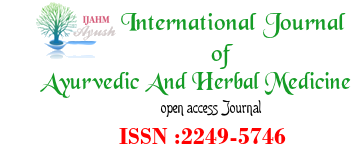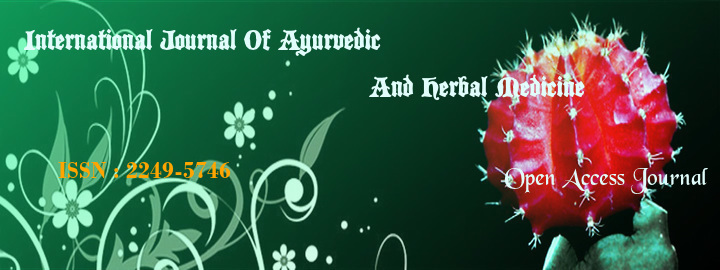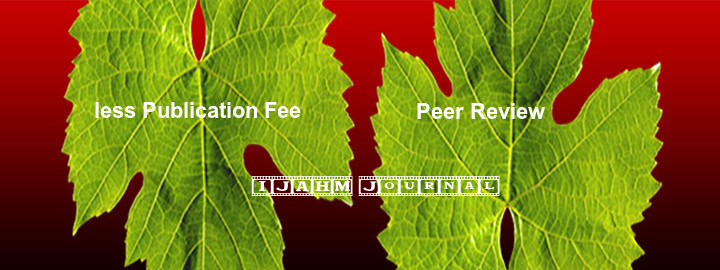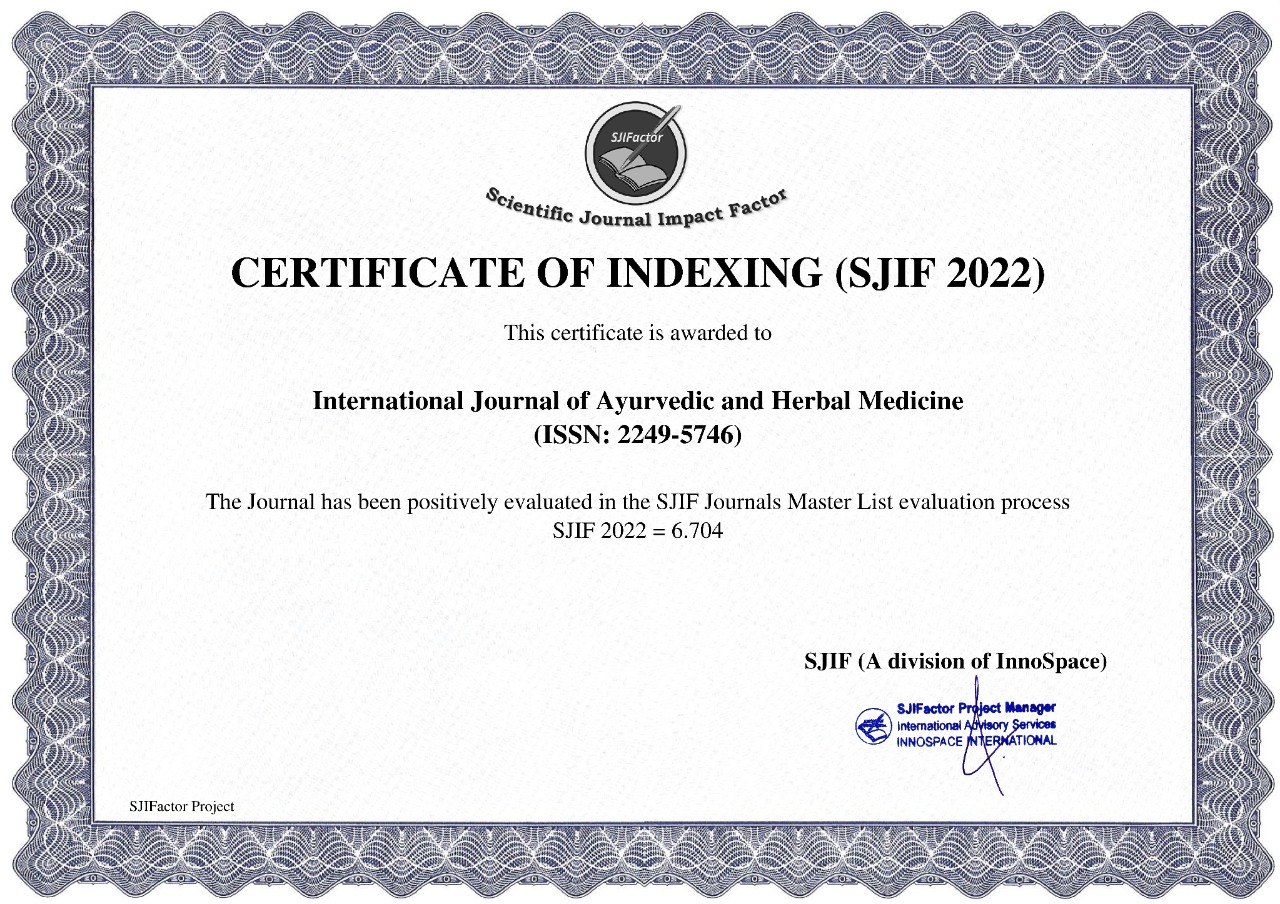


Nigam V. and *Nambiar V.
Foods and Nutrition Department, Faculty of Family and Community Studies,
M.S. University of Baroda, Vadodara-02, Gujarat
*Corresponding author: Dr. Vanisha S. Nambiar
Email Id: This email address is being protected from spambots. You need JavaScript enabled to view it.
Abstract
Background: Aegle Marmelos (L.) Correa belonging to family Rutaceae known in India from Vedic or prehistoric times is an important medicinal plant of India. There is wide genetic variability in terms of quality, form and size of the fruit. Aegle marmelos leaves are used as anti-diabetes agent in Ayurveda, Unani & Siddha Systems of Medicine
Materials and Methods: Aegle Marmelos leaves from the two varieties namely wild variety from Gir Somnath forest and newly cultivated variety “Goma yashi” were analysed chemically for proximate composition, available protein, fat, carbohydrates, fiber, mineral content and heavy metals. The values for the physico-chemical constituents and minerals is reported in percentage and heavy metals is reported in ppm.
Results: The wild variety was superior to the cultivated variety in terms of nutritional components like carbohydrates, protein, fiber, moisture content, ash content and many of the trace elements like Cu, Fe, Mn, Zn, Ca, Vanadium, Gold etc. However heavy metals like lead, arsenic, mercury and cadmium were not detected in either of the variety proving it to be non-toxic.
Conclusions: From the present study it is concluded that presence of various inorganic trace elements could account for the hypoglycaemic nature of the plant. Further, the data obtained on individual element concentration in the plant will be useful in deciding the dosage of herbal drugs prepared from this plant material for the management of diabetes-related metabolic disorders. The wild variety can further be exploited to isolate the bioactive constituents for its therapeutic claim.
REFERANCES
1. 1. Dhankhar, S. Ruhil, M. Balhara, S. Dhankhar, A.K. Chhillar, Journal of Medicinal Plants Research, 2011, 5, 1497-1507.
2. Roy S.K. and Singh R.N. Studies on utilization of bael fruit for processing II Extraction of Bael fruit pulp Indian Food Pac. 1979; 33(1); 5-9
3. Chopra R.N.; Indigenous Drugs of India; Academic Publishers, Calcutta (1982)
4. Charaka-Samhita, (Ed.) G.S. Pandeya, Chowkhamba Sanakrit Sansthan, Varanasi, (1983)
5. Chakravarty S. Mohanty A, Sudha TN, Upadhyay AK, Konar J, SircarJk et al.Removal of Pb (II) ions from aqueous solution by adsorption using bael leaves (Aegle marmelos). J Haz Mat 2010, 173;502-509
6. P.C. Sharma, v. Bhatia, N. Bansal, A. Sharma, Natural Product Radiance, 2007, 6, 171-178.
7. Rathore M., Journal of Horticulture and Forestry, 2009, 1, 103-108.
8. Maity P., Hansda D., Bandopadhyay U. and Mishra D.K. Biological activities of Crude extracts and chemical constituents of Bael, Aegle marmelos (L.) Corr.2009. Indian Journal of Experimental Biology, 2009; vol 47,(nov); pp 849-861.
9. Govindachari TR, Premila MS. Some alkaloids from Aegle marmelos. Phytochem.1983; 22: 755.
10. Riyanto, S; Sukari MA; Rahmani M; et al."Alkaloids from Aegle marmelos (Rutacea).". Malaysian J Anal Sci.2001 7 2: 463–465.
11. Lanjhiyana, S; Patra KC; Ahirwar D; et al. "A validated HPTLC method for simultaneous estimation of two marker compounds in Aegle marmelos (L.) Corr., (Rutaceae) root bark.". Der Pharm Lett. 2012 4 1: 92–97.
12. Venkatesan D, Karrunakarn CM, Selva SK and Palani PTS. Identification of Phytochemical Constituents of Aegle marmelos Respon sible for Antimicrobial Activity against Selected Pathogenic Organisms. Ethnobotanical Leaflets 2009;13: 1362-72.
13. Kaur HP, Garg SN, Sashidaran KV, Yadav A. Chemical composition of essential oil of the twigs and leaves of Aegle marmelos (L.) Correa. J Essen Oil Res. 2006; 16: 144-145.
14. Rajadurai H, Prince PSM. Comparative effects of Aegle marmelos extract and α-tocopherol on serum lipids, lipid peroxidase and cardiac enzymes levels in rats with Isoproterenol induced myocardial infarction. Singapore Med J. 2005; 46(2): 78.
15. Upadhya S, Shanbagh KK, Sunneetha G, Balachandra Naidu M. A study of hypo glycaemic and antioxidant activity of Aegle marmelos in alloxan induced diabetic rats. Indian J Phsiol Pharmacol. 2004; 48(4): 476-480.
16. Dahanukar SA, Kulkarni RA, Rege NN. Pharmacology of medicinal plants and natural products. Indian J Pharmacol. 2000; 32: S81-S118.
17. Sharma PC, Bhatia V, Bansal N and Sharma A. A review on Bael Tree. Natural Product Radiance 2007 6(2): 171-178.
18. Parichha S. Bael (Aegle marmelos) Nature's Most Natural Medicinal Fruit. Orissa Review, 2004; 16-17.
19. Narender T, Shweta S, Tiwari R, Papi Reddy K, Khaliq T, Prathipati P, Puri A, Srivastava AK, Chander R, Aggarwal SC, Raj K. Anti hyperglycemic and anti dyslipidemic agent from Aegle marmelos. Bioorg Med Chem Lett. 2007; 17(6):1808-1811.
20. Yaheya M and Ismail M. Clinical Evaluation of Antidiabetic Activity of Bael Leaves. World Applied Sci J 2009. 6(11): 1518-1520.
21. Narendhirakannan R.T, Subramanian S, and Kandaswamy M. Mineral Content of Some Medicinal Plants Used in the Treatment of Diabetes Mellitus. Biological Trace Element ResearchVol. 2005;103
22. Shankhla A, Sharma S and Sharma N. Hypoglycemic effect of bael patra(Aegle marmelos) in NIDDM patients. J Dairying, 2009; Food and Home sci 28: 3-4.
23. Mandal PK, Mukherjee AK. Investigation on partial structure of a glycoprotein from bael seed. Carb Res.1981; 98(1): 85-91.
24. Thorfeldt S. Herbs in diabetes mellitus. Alt Med Rev 2005. 9 ;13-18.
25. Sachdewa A, Raina D, Srivastava AK, Khemani LD. Effect of Aegle marmelos and Hibiscus rosa sinensis leaf extract on glucose tolerance in glucose induced hyperglycemic rats (Charles foster). J Environ Biol. 2001; 22(1): 53-57.
26. Bhushan MS, Rao CHV, Ojha SK, Vijayakumar M, Verma A. An analytical review of plants for anti-diabetic activity with their phytoconstituent & mechanism of action. Int J Pharm Sci Res. 2010;1(1):29–46.
27. Ponnachan PTC, Paulose CS, Panikkar KR. Hypoglycaemic effect of alkaloid preparation from leaves of Aegle marmelos. Amala Res Bull. 1993; 13: 37–41.
28. WHO 2008. World health Statistics (http://www.who.int/whosis /whostat /2008 /en/)
29. K. Wierzchowska-Renke, S. Ivancheva, and M. Kurteva, Effect of environment polluion on the composition of polyphenol and bioelements content in Achillea millefolium L. and Tanacetum vulgare L., Herba Pol. 1997; 43, 413–418
30. Oluwole AF, Asubiojo OI, Adekile AD, Filby RH, Bragg A and Grimm CI. Trace element distribution in the hair of sickle cell anemia patients and controls. J. Biol. Trac. Elm. Res. 1990; 26-27: 479-484
31. Central Council for Research in Ayurveda and Siddha. HPTLC-Fingerprint atlas of Ayurvedic single plant drugs mentioned in Ayurvedic Pharmacopoeia Vol-III and IV-A. report submitted to WHO, India, pp3-4
32. Shankar G, Garg KL. Nutritional value of some important fruits. Handbook of Horticulture, Kitabistan, Allahabad. 1967
33. Rathore M. Nutrient content of important fruit trees from arid zone of Rajasthan. J Hort Forestry 2009; 1:103-108.
34. Bhati, R., N.S. Shekhawat and H.C. Ary In vitro regeneration of plantlets from root segments of . Indian J. Exp. Biol. 1992; 30: 844-845.
35. Pati R and Muthukumar S. Histological and biochemical changes in Aegle marmelos Corr. Before and after acclimatization. Tree Genetics and Molecular Breeding 2013 3(3),12-18.
36. A.O.A.C. Official methods of analysis. Association of official analytical chemists. Inc. 17th ed. Arlington, Virginia. 2000. USA.
37. Dubois, M., Giller, K. A., Rebers, P. A. and Smith F. Colorimetric method for determination of sugars and related substances. Anal. Chem. 1956; 28: 350-356.
38. Lowry O. W., Rosebrough N. J., Farr A. C. and Randall R. J. “Protein measurements with folin-phenol reagent”. J. Biol. Chem., 1951; 193: 255-257
39. The Ayurvedic Pharmacopoeia of India, Part I, volume-IV, Ministry of Health and Family Welfare, Department of Ayush, New Delhi, 1982.pp 13-14.
40. The Ayurvedic Pharmacopoeia of India, Part I, volume-III, Ministry of Health and Family Welfare, Department of Ayush, New Delhi, 1982,pp 29-31.
41. Vermani, A., Prabhat, N. and Chauhan, A. Physico-Chemical Analysis of Ash of Some Medicinal Plants Growing in Uttarakhand, India. Nature. Science.2010, 8(6): 88-91
42. Kelsay, J. L.Effects of diet fiber on bowel function and trace mineral balances of human subjects. Cereal Chem.1981; 58: 2-5.
43. Le Veille, G. and Sanberlich, H.E. Mechanism of the cholesterol- dressing effect of pectin in the cholesterol fed rat. J. Nutr.1966; 209-214.
44. Abolaji O. A., Adebayo A. H and Odesanmi, O. S. Nutritional Qualities of Three Medicinal Plant Parts (Xylopia aethiopica, Blighia sapida and Parinari polyandra) commonly used by Pregnant Women in the Western Part of Nigeria. Pak. J. Nut. 2007;6(6): 665-668
45. Narendhirakannan RT, Subramanian S, Kandaswamy M. “Mineral content of some medicinal plants used in the treatment of diabetes mellitus”, Biol. Trace Elem. Res. 2005; 103(2): 109-115.
46. Singh U., Anita Kochhar A. and Boora R. Proximate Composition, available Carbohydrates, Dietary Fibres and Anti-Nutritional factors in BAEL (Aegle Maemelos L.) Leaf, Pulp and Seed Powder International Journal of Scientific and Research Publications 2012; Volume 2, Issue 4
47. Dandapat S. , Kumar A. and Sinha M.P. Antipathogenic efficacy of methanolic leaf extract of Cinnamomum tamala and with their nutritional potentiality. The Biocon; 2013 8 (2), Supplement on Medicinal Plants 635-641
48. Bhatti R., Singh J., Saxena A.K., Suri N. and Ishar M.P.S. Pharmacognostic standardisation and antiproliferative activity of (L.) Correa leaves in various human cancer cell lines. Ind J Pharm Sci. 2013 Nov-Dec; 75(6): 628-634.
49. Janarthanan U., Varadhrajan V. and Krishnamurthy V. Physicochemical Evaluation, Phytochemical Screening and Chromatographic Fingerprint profile of Aegle marmelos (L.) Leaf extracts. World Journal of Pharmaceutical Research; 2012, vol. 1(3); 813-837.
50. Khan SA, Ahmad I And Mohatir N.S. Evaluation of mineral contents of some edible medicinal plants. Pak J Pharm Sci 2006 Apr; 19(2): 148-52
51. Vinodhini R, Narayanan M. Cytoprotective effect of Nelumba nucifera and Aegle marmelos in common carp (Cyprinus carpio) exposed to heavy metals. International Journal of Integrative Biology 2009; 7(2): 124-129.
52. Annan K, Dickson A., Amponsah I and Nooni I. K. The Heavy metal contents of some selected medicinal plants sampled from different geographical location. Pharmacognosy Res. 2013 Apr-Jun; 5(2): 103–108.
53. Mihucz V.G, Tatar E., Kmethy B., Zaray G., and Cseh E., Investigation of transportedheavy metal ions in xylem sap of cucumber plants by size exclusion chromatographyand atomic absorption spectrometry, J. Inorg. Biochem. 2000 81, 81–87.
54. Heyliger C.E., Tahiliani A.G., and McNeill J.H., Effect of vanadate on elevated bloodglucose and depressed cardiac performance of diabetic rats, Science 1985; 227, 1474
55. Schecter Y. and Karlish S. J. D. Insulin-like stimulation of glucose oxidation in rat adipocytes by vanadyl(IV) ions, Nature 1980; 284, 556
56. Schecter Y and Ron A., Effects of depletion of phosphate and bicarbonate ions on insulin action in rat adipocytes, J. Biol. Chem. 1986; 261, 14,945
57. Rosetti L Giaccari A., Klein-Robbenharr A.E., and Vogel L.R., Insulinomimetic proper-ties of trace elements and characterization of their in vivo mode of action, Diabetes 1999, 39, 1243
58. V.G.Yuen, E.Vera, M.L.Battell, W. M. Li, and J. H. McNeil, Acute and chronic oral administration of bis (metallato) oxovanadium(IV) on fa/fa Zucker diabetic fatty (ZDF)rats, Diabetes Res. Clin. Pract. 1999, 43, 9
59. J. Clin. Invest.17CrossRef
60. Am. J. Clin. Nutr.37
61. J. Biol. Chem.1982; 257
62. J. Nutr. 123
63. William DM. Copper deficiency in humans, Semin Hematol, 1983, 20; 118-128
64. J. Adv. Med. 8
65. J. Trace Elements Exp. Med. 11 CrossRef
66. Appl. Radiat. Isot. 497 CrossRef
67. J. Biol. Chem. 1949; 178
68. Kar A., Choudhary B.K.and Bandyopadyay N.K. Preliminary studies on the inorganic constituents of some indigenous hypoglycemic herbs on oral glucose tolerance test, J. Ethnopharmcol 1999. 64, 179–184.
69. Agarwal VS. Rural economics of medicinal plants: Vegetation in the forest. In: Drug plants of India. New Delhi, alyani Publishers, 1997, pp 1, 6, 44, 45, 102, 103, 129, 160.
70. Bael (Aegle marmelos). Medicinal plants, herbs, spices. The Tribune. Online edition. www.tribuneindia.com
index























